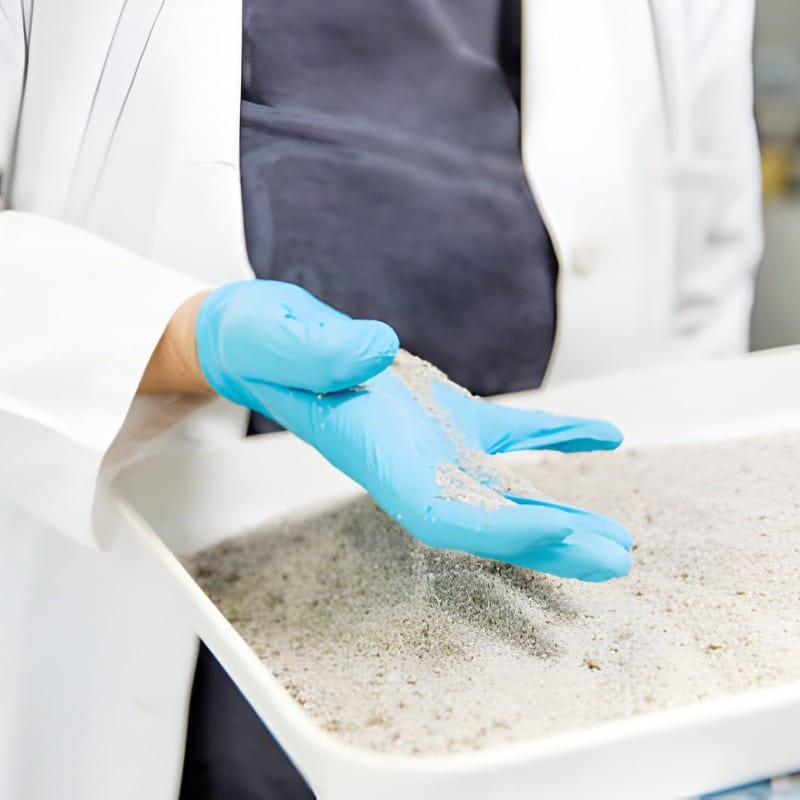Sand Resistance SPF Laboratory Test In Vivo – Sun Protection Factor
€2,100.00 – €2,700.00
- Description
- Additional information
The Sand Resistance SPF Laboratory Test In Vivo is a clinical evaluation that measures a sunscreen’s ability to maintain its Sun Protection Factor (SPF) after contact with sand. This test replicates real-life beach and outdoor conditions to assess how well a product resists the effects of sand adhesion, friction, and removal, ensuring reliable UV protection during outdoor activities.
Purpose of the Test
The purpose of this test is to determine whether a sunscreen maintains its protective performance after sand contact and removal. It supports claims such as “sand resistant,” “ideal for beach and outdoor use,” and “SPF protection unaffected by sand.” The study follows the standards outlined in ISO 24444:2019 and ISO 18861 for In Vivo SPF and resistance testing.
How the Test Works
This In Vivo Apparatus Test is conducted on human volunteers in controlled conditions simulating sand exposure. After the product is applied and dried, standardized sand is applied to the test area under gentle pressure. The sand is then removed by a defined mechanical or air-blowing procedure. SPF is measured before and after sand exposure by determining the minimal erythema dose (MED) required to cause redness under UV radiation. The change in SPF value reflects the product’s resistance to sand-induced effects.
Testing Standards
- ISO 24444:2019 — In Vivo determination of Sun Protection Factor (SPF)
- ISO 18861 — In Vivo determination of resistance properties of sunscreen products
Applications in Cosmetic Testing
- Verification of “sand-resistant” claims for beach and outdoor sunscreens
- Evaluation of SPF retention after physical contact with sand
- Validation of product performance under real-use environmental conditions
- Regulatory compliance testing for sun care products marketed for outdoor use
- Support for claims such as “non-sticky,” “non-transfer,” and “long-lasting protection”
Test Procedure
- The study is conducted according to ISO 24444:2019 and ISO 18861 methodologies under controlled light and temperature conditions.
- The test sunscreen is applied in a standardized quantity on volunteers’ skin and allowed to dry fully.
- Defined sand grains are applied to the treated skin using a standardized mass and contact pressure.
- After a defined exposure period, the sand is removed mechanically or with controlled airflow.
- UV exposure is applied to determine SPF values before and after sand exposure, measuring SPF retention and resistance.
Results & Reporting
The final report includes:
- Complete study protocol and compliance statement
- SPF measurements before and after sand exposure
- Statistical data showing SPF retention percentage
- Volunteer test results and evaluation summaries
- Interpretation confirming “Sand Resistant” performance capability
Why This Test Matters
At the beach or during outdoor activities, sand can adhere to the skin, affecting sunscreen distribution and protection. The Sand Resistance SPF Laboratory Test In Vivo verifies that a product continues to deliver effective UV protection even after direct sand exposure and removal. This ensures the product performs reliably in real-world conditions and meets consumer expectations for durability and protection.
Sample Requirements
- Sample size: 300 mL of finished product
- Number of volunteers: typically 10–20, in accordance with ISO standards
- Product type: sunscreens, beach lotions, and outdoor SPF creams
- Storage: room temperature, away from light and heat unless otherwise specified
Test Parameters
- Protocol: ISO 24444:2019 + ISO 18861
- Duration: 40 days (including preparation, testing, and analysis)
- Measurement: SPF values before and after standardized sand exposure
- Simulation: sand adhesion and removal using controlled mechanical application
- Sample quantity: 300 mL
Turnaround Time
The typical turnaround time for the Sand Resistance SPF Test is approximately 40 days, depending on volunteer scheduling and laboratory conditions.
Deliverables
- Comprehensive laboratory report in PDF format
- SPF data and resistance evaluation results
- Statistical summary confirming sand resistance performance
- Certificate validating compliance and product claim eligibility
Compliance & Standards
The Sand Resistance SPF Laboratory Test In Vivo is performed under Good Clinical Practice (GCP) and in accordance with ISO 24444:2019 and ISO 18861. All procedures are executed by trained professionals in controlled environments to ensure reproducibility, scientific accuracy, and regulatory validity.
Related Tests
- Water Resistance SPF Laboratory Test In Vivo – Sun Protection Factor
- Very Water Resistance SPF Laboratory Test In Vivo – Sun Protection Factor
- Sweat Resistance SPF Laboratory Test In Vivo – Sun Protection Factor
- Photostability & UV Filter Efficacy Test
Additional information
| SPF Test | SPF < 50, SPF <30, SPF 50 + |
|---|



